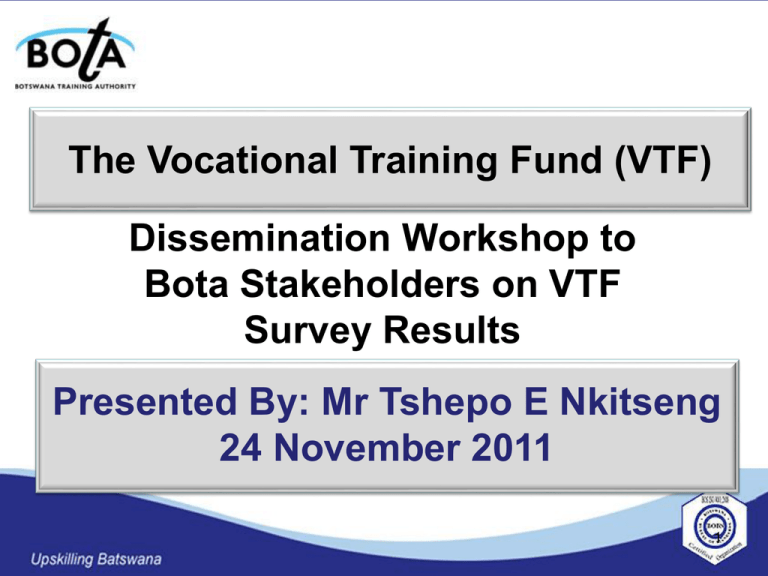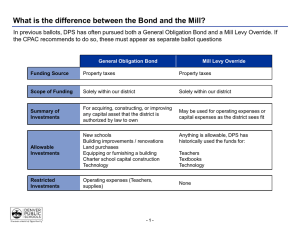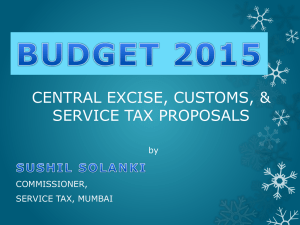BCM VTF Study Presentation 21 Oct 2011
advertisement

The Vocational Training Fund (VTF) Dissemination Workshop to Bota Stakeholders on VTF Survey Results Presented By: Mr Tshepo E Nkitseng 24 November 2011 1 Presentation Overview • • • • Introduction Administration of Fund Payment and Calculation of Levy Reimbursements 2 Introduction Introduction Informed by : •1993 Commission on Education • Revised National Policy on Education (1994) • National Policy on V E & Training (1997) • Vocational Training Act (1998) • Pre-Implementation Seminars (2007/2008) •Vocational Training (reimbursement ) No8/08 • Vocational training (levy ) no 101 0f 2008 •Levy payments commenced October 2008 3 GOALS • To generate sufficient funds to support skills training by employers and therefore increase skills base at the workplace • Support the goal of cost-sharing in skills development in Botswana • To bring together supply and demand for training • Create opportunities in the training market 4 Payment Calculation • The amount of levy is based on the annual turnover of any Botswana company that is registered under the VAT Act or is liable for VAT at the following rates: – Annual turnover of P500,000 – P2 billion- levy = 0.2% of turnover – Annual turnover of more than P2 billion, contribution is 0.2% of turnover for the first 2 billion and 0.05% for any amount in excess of the P2 billion. – Oil Industry, contribution is a flat 0.05% on turnover relating to petroleum products 5 Reimbursement • Company must be up-to-date in paying Levy • Vocational Training that falls within the regulatory requirements (Accredited Institution or workplace) • Only training of citizens is claimable except for special cases where training of non-citizens is approved in advance by BOTA. • Prior approval by BOTA for training sourced outside Botswana 6 Reimbursement Formula/ Limit • There are two grant limits • 1) Limit based on amount of Levy (Formula) – Every P1.00 paid as levy up to a maximum of P1,000.00 shall generate a grant of P5.00 – Every P1.00 paid as levy in excess of P1,000.00 but below P5,000.00 shall generate a grant of P2.50 Every P1.00 paid as levy in excess of P5,000.00 shall generate a grant of P1.25 2) The total training costs incurred The approved reimbursement is the lesser of the two limits. 7 Reimbursement Formula/ Limit • Example: If turnover =P1,000,000 then Levy paid = P2,000 1) Grant limit based on levy is: P1000*5 +P1000*2.5 = P7,500.00 2a) If training costs are P10,000 Then the approved reimbursement will be P7,500.00 2b) But if training cost incurred is P4500 Then the approved reimbursement will be P4500 8 Application for Reimbursement • Use the VTF claim form( from BOTA or www.bota.org.bw) and attach the following: • Certified copy Omang for person(s) trained; • Original receipts or certified copies showing payment for tuition, accommodation, transport, meals and stationary; • Signed spreadsheet showing salary data; • Certified trainee transcripts or certificates showing competencies; • Certified copies of attendance register; • Pre - Approval letter, if training was outside Botswana When can I Claim? 1st April 31st March 30th June Window Period Claims must have been lodged with the Authority on or before the 30th of June of each year EXEMPTIONS • Entities with an Annual Turn-over of less than P500, 000.00; • Entities exempt from registering for VAT; • Companies registered with Diamond hub; • Companies registered with Innovation hub; (Exemption for the last two is for 5 years from date of registration ) Allocation to Special Groups At the beginning of each financial year, BOTA shall allocate funds as follows: • 2.5% for special groups • 1% for skills in emergent industries • 5% for small micro and medium enterprises 12 Claims as at 30th Sep 2011 Levy Payers Beneficiaries Number of Employees up-skilled through VTF ±10000 2748 Applications (723 companies) 19084 Levy Update Information • • • • Total number of Levy paying organisations ± 10000 Cumulative collection as at end of October 2011: P517 Million Cumulative claims paid as at end October 2011: P 84 Million Coming from 731 Companies: ≈ 7% 14 Vocational Training Fund Survey Results Presented By Mr Mathews Phiri Objectives of the study 1) To assess the major achievements of the Fund to date in relation to its stated objectives and intended results: Assess what has been achieved, the likelihood of future achievements, and the significance/ strategic importance of the achievements. Opinions on the Fund’s effectiveness based on impressions and interviews with target groups. Describe any major failures to date Objectives cont….. 2)The level and specific nature of the companies concerns in relation to the Fund. 3)Additional regulatory arrangements that can be done to promote the usage of the Fund and bring benefit 4)Any other relevant matter that can enhance the development of human capital through the Fund. Target population All companies that were registered with BURS and eligible to contribute, claim or use the Vocational Training Fund by the end of December 2010. ±9000 companies A self administered questionnaire was used to collect data for the study. Simple random sampling was used and 600 questionnaires were sent out to levy payers. 353 completed questionnaires were received back. Analysis Data entry, cleaning and analysis were done using Statistical Package for Social Sciences (SPSS) and Microsoft Excel Results Response by company type Key: Company Type Frequency NGOs Parastatal Training Institution Work-based 5 8 10 10 Private Total 320 353 Awareness of the VTF among companies Are you knowledgeable about the VTF? Frequency Percent Yes 242 69 No 111 31 Total 353 100 Effective means of disseminating information on VTF. How would you prefer us to provide most communication about the VTF Frequency Percent Email 186 53.4% Phone 20 5.7% Postal Mail 39 11.2% Face to Face 33 9.5% BOTA Website 66 19.0% Other 4 1.1% Total 348 100.0% Training by Employer Does your Organization/Company train its staff? Frequency Percent (%) Yes 297 84 No 56 16 Total 353 100 Reasons for not training staff 46.3 17.1 14.6 4.9 Lack of funds No need for Employees do training as staff not see the need are either for training qualified or learn on the job 9.8 7.3 No accredited training institutions in location of Company Training to be organised in future/still growing Other Levels of training required by industry: Certificate Level Very Important, 19.78% Most Important, 44.78% Important, 23.50% Not Important, 5.97% Less Important, 5.97% Diploma Level Less Important, 9.84% Not Important, 9.45% Most Important, 20.47% Important, 29.13% Very Important, 31.11% Degree Level Less Important, 16.08% Important, 23.14% Not Important, 16.07% Very Important, 15.69% Most Important, 29.02% Employers perception on what they like about the VTF 50 45 42 40 Percentages 35 30 26 25 20 16 15 10 10 6 5 0 Develops and empowers staff/employees Encourages companies to train Staff support/Assistance to VTF customers Have no complaints about VTF Good initiative Major Challenges faced by employers Reasons for dislikes about the VTF Employers perception on what they dislike about the VTF Percentage (%) Procedures and documentation for accessing the Fund too cumbersome 41 Adequate information about the VTF is not provided 21 Does not cover degree/professional courses 17 Delay in payments 9 Fund is irrelevant to the needs this organisation 7 Other 5 Total 100 Major challenges facing the VTF Division Few claims In complete submissions Use of non-accredited training providers Companies not seeking pre-approvals No training needs analysis/plan done Exorbitant Pricing of programmes by VTI’s when doing training for Levy payers; Limited scope of training; An influx of training providers in Botswana Major challenges faced by Companies in their efforts to train Lack funding to finance training before re-imbursement No relevant institution/trainers locally Staff turn-over after training Other Lack of support for post certificate training by the VTF Lack of time Lack of motivation for self improvement Replacement of workers on training 8% 9% 7% 7% 7% 12% 26% 24% Suggested Improvement to the operations of the VTF 40 35 Code 1 2 3 4 5 6 7 8 9 10 34.7 30 25 20 15.7 15 13.2 10.7 10 7.4 5 5 5 3.3 3.3 1.7 0 1 2 3 4 5 6 7 8 9 10 Variable More information on the VTF to beneficiaries VTF to cover post certificate training Reimburse trainers directly Time taken to process applications for reimbursement should be reduced Service delivery by VTF officers Other Period for claims should be extended No changes required VTF to be made user friendly VTF to cover courses that are not accredited Suggestions to the funding scope 70 65.7 60 50 40 30 16.4 20 14.9 10 3 0 Tertiary/Professional courses Internship/on the job training/attachments Incentives to trainees Other Suggestions to provide quality accredited training 25.0 % of the Respondents 22.2 22.2 18.9 20.0 15.0 12.2 11.1 10.0 7.8 5.6 5.0 0.0 Pre-finance/Reimburse trainers directly Provide companies with information on BOTA accredited institutions Provide information on VTF to companies Quality of trainers and assessors should be improved Simplify VTF procedures VTF should cover post certificate training Other Recommendations BOTA should consider increasing the use of the email and the website to communicate with levy payers. The Authority should provide adequate information and education about the VTF. The procedures and documentation guiding the application for reimbursement should be reviewed, with the aim of making them more user-friendly and quicker to applicants. The scope of the Fund should be reviewed to include other levels of training beyond certificate such as diploma, degree, masters, professional courses (CIMA, ACCA, AAT, MBA etc) and work improvement seminars. The Fund should be used to support other training related activities such as: • Internships, attachments and on the jobtraining • Conducting training needs analysis for companies which pay the levy • Paying for training materials • To cover for product related training, such as those commonly carried out by manufacturers and distributors. The Fund should pay for training costs upfront alongside the reimbursement approach. This will assist levy payers who are experiencing cash flow problems. For growth in quality training, the VTF should also be used to upgrade trainers for them to attain full accreditation. Lack of qualified trainers is a serious problem in Botswana Considerations should be made for the Fund to cover employees who have paid for their own training, by allowing them to submit claims through their employers- if their employers are levy payers. BOTA should consider developing standardized forms which would be used when applying for training outside Botswana. “UP SKILLING BATSWANA” THANK YOU





